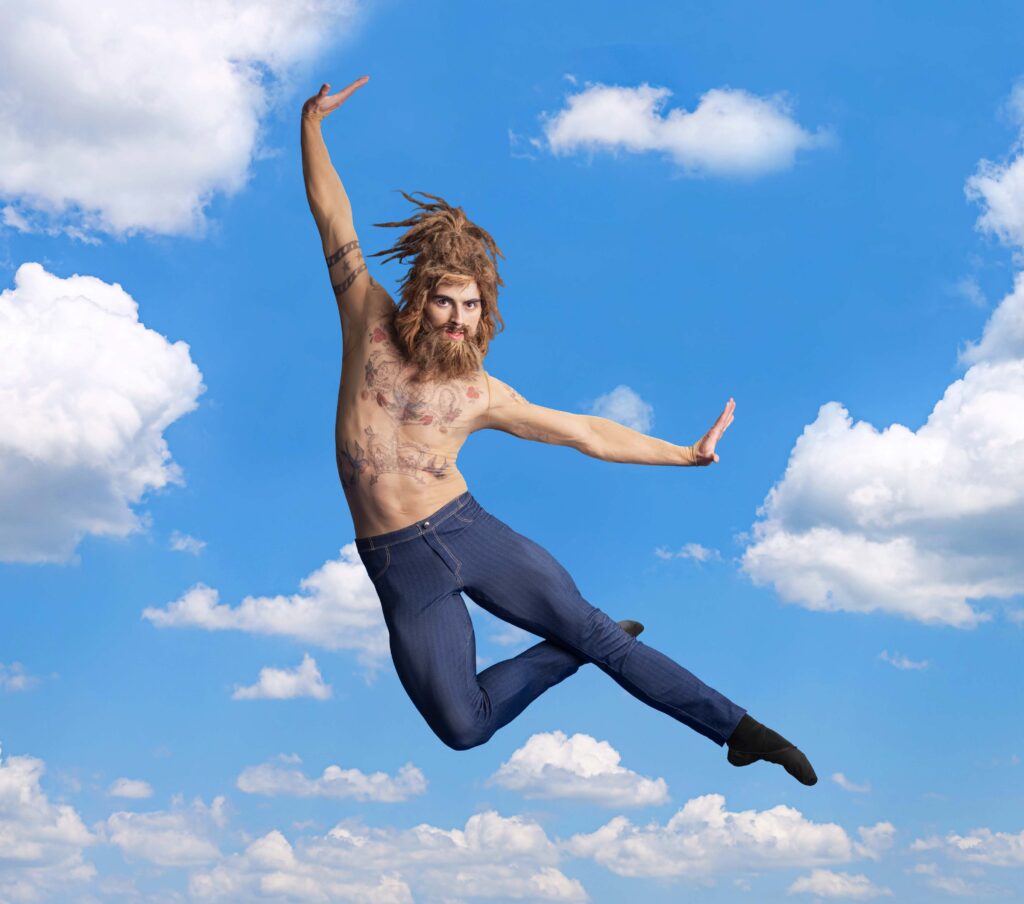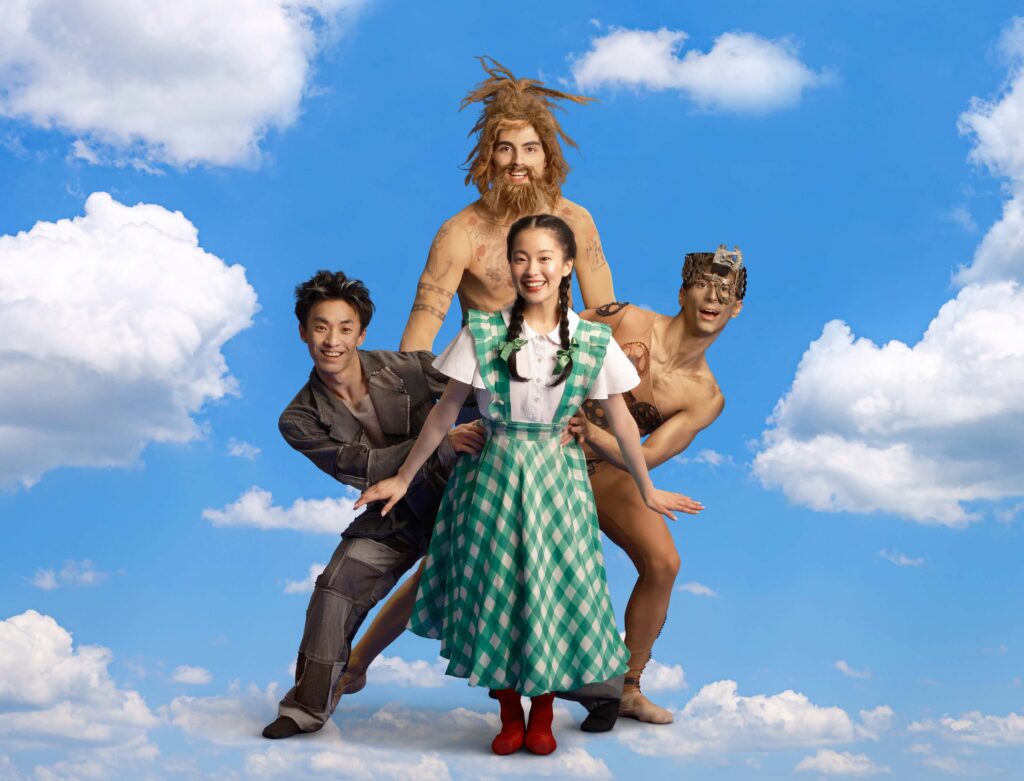Canadian Premiere of Francesco Ventriglia’s imaginative journey heralds “The Greatest Season Ever Told”
By Lauren Kalinowski




There is something boldly surrealist about Alberta Ballet’s Canadian premiere of “The Wizard of Oz,” choreographed by Francesco Ventriglia. The production, which opened March 21 in Edmonton, reimagines L. Frank Baum’s beloved tale through a fresh lens that feels both nostalgic and daringly contemporary.
A Hospital Dream Transforms
Ventriglia’s adaptation begins not in Kansas, but in a children’s hospital, a personal touch reflecting how he first discovered the story. This framing device cleverly establishes the dreamlike quality that permeates the entire production. As clouds reminiscent of vintage computer wallpaper float above and an IV drip with bright green fluid stands beside a central bed, we’re immediately transported to a space between reality and imagination.
The dancers enter with delicate skips and precise heel kicks en pointe, their dramatic makeup and 1920s-inspired swim costumes with flowered caps creating a visual language that sits firmly in the realm of modern ballet while honoring classical techniques. This juxtaposition becomes a hallmark of the production: the familiar made strange, the traditional reimagined.
Character Through Movement
Dorothy, dressed initially in yellow ginham and carrying a stuffed Toto, embodies innocence through her movement vocabulary. Ventriglia has preserved Judy Garland’s wholesome portrayal with two braids and a gingham dress, perhaps to a fault. At times this interpretation feels overly safe when contrasted with the production’s more daring elements.
The character interpretations through movement are where this production truly shines. The Scarecrow, with his bouffant hair and patchwork costume, moves with the floppy unpredictability of a ragdoll puppet. The Tin Man executes straight-legged pirouettes with mechanical precision that evokes both Nutcracker and European living statue street performers, his silver-painted face and gear-adorned tights creating a striking visual. Most compelling is the Lion. He’s wolfish, shirtless, and clad in jeans. He executes his turns with an effortless power that belies the character’s supposed cowardice.
A Visual Feast
The production design creates distinct worlds for each segment of Dorothy’s journey. The Emerald City sequence transforms into a 1920s flapper paradise with swing dancing set incongruously yet effectively to classical piano. This French-inspired segment features dancers in sequins that catch the light magnificently, creating an atmosphere of effervescent joy that ripples through the audience.
In sharp contrast, the Wicked Witch’s domain features hanging black chandeliers that introduce a gothic element, populated by her flying monkeys who are androgynous, bare-chested creatures with hoods and skirts that evoke gargoyles. Their transformation after Dorothy acquires the golden turban hat (this production’s version of the witch’s hat) represents one of the evening’s most visually striking moments.
Technical Highlights
The company displays impressive technical prowess throughout. The quartet of teacups in the China Tea sequence move with impeccable synchronization on quick, precise footwork. The principal dancers execute challenging lifts and extensions with apparent ease. Dorothy’s full side splits seem effortless, while the male dancers demonstrate remarkable strength in their partnering work.
The poppy field scene transforms into a Cabaret-inspired interlude with dancers in bright red wielding cigarette holders, creating a sensual atmosphere that contrasts with the production’s otherwise family-friendly tone. The slow-motion fight scene between the Cowardly Lion and a second yellow cat (brilliantly danced by Dylan West and Mirko Melandri) provides welcome physical humor with cleverly choreographed moves that showcase both technical skill and character development.
Musical Disconnect
If there is a significant weakness in the production, it lies in the relationship between movement and music. Francis Poulenc’s score, while beautiful, sometimes feels disconnected from the dance, particularly during the Emerald City sequence where swing inspired movement meets classical piano. The absence of live music is keenly felt, as the recording lacks the breathing, responsive quality that might have better unified the production’s disparate elements. (This absence will be somewhat addressed in the upcoming season, with Ventriglia announcing live orchestral accompaniment for both “Swan Lake” and the newly reimagined “Nutcracker.”)
Storytelling Challenges
At times, Ventriglia’s production sacrifices dance for storytelling, relying heavily on mime and literal movement interpretation. This creates moments where the narrative feels flattened, particularly during transitional scenes. The metaphorical elements, particularly in the finale where clown noses feature prominently as symbols of childhood and innocence, occasionally veer into territory that feels confusingly heavy-handed.
The final scenes, with their hospital scrubs and uncertain symbolism around Dorothy’s fate, leave some ambiguity. Has she awakened from a coma? Is she dead? Is this a meditation on the loss of childhood? While thought-provoking, these questions sometimes overpower the emotional impact of the dancing itself.
A New Direction
“The Wizard of Oz” serves as a perfect introduction to Artistic Director Francesco Ventriglia’s ambitious vision for Alberta Ballet, recently unveiled as “The Greatest Season Ever Told” for 2025/26. This production’s inventive reimagining of a classic narrative perfectly aligns with Ventriglia’s stated philosophy of “honouring classical tradition while embracing bold, imaginative storytelling.”
The attention to visual spectacle evident in Oz with Gianluca Falaschi’s imaginative costume and set design will continue in the upcoming season. Personally, the writer is excited for the new production of “The Nutcracker” (also designed by Falaschi) as the past set and choreography is tired at 16 years running. The world premiere of “Romeo & Juliet” features work by three time Academy Award winner James Acheson, a British costume designer.
Perhaps most significantly, Ventriglia’s commitment to elevating the company’s productions is evident in the announcement that live orchestral music will return for two major productions: “Swan Lake” and “The Nutcracker”, addressing the absence noted in “The Wizard of Oz.”
The enthusiastic audience response to “Oz” in whistles, cheers, and the inevitable standing ovation in a nearly full house confirms that this direction resonates with Edmonton audiences. Particularly heartening was the presence of multiple generations, from little girls in sparkly dresses (including one in full Dorothy costume, braids and all) to seniors who took advantage of the day-of $40 discount tickets.
As Alberta Ballet moves forward with an epic seven-show season featuring reimagined classics like “Swan Lake” and rarely seen works like Roland Petit’s “Notre Dame de Paris,” “The Wizard of Oz” stands as a colorful declaration of intent: to create ballet that speaks to contemporary audiences while honoring the timeless power of this art form to transport us to worlds beyond our imagination.
Note: The Alberta Ballet offers pre-performance talks approximately 90 minutes before curtain time that provide valuable context for each production. Season subscriptions for the newly announced 2025/26 season start at $292.



